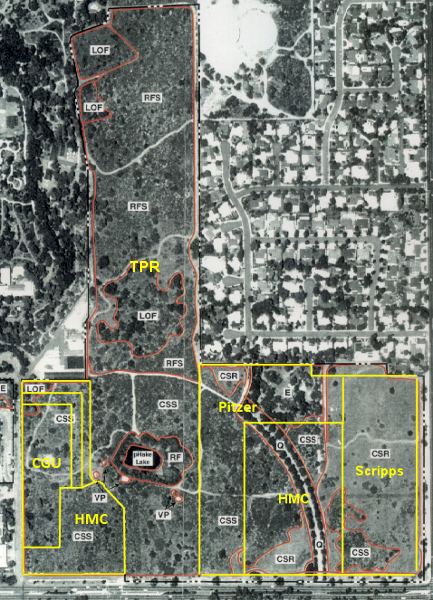The Bernard Biological Field Station:
A Short History, 1920s-2015
In the 1920s, there was pressure on Pomona College to expand. Instead of Pomona getting larger, President Blaisdell proposed that more small colleges be formed. He and Robert J. Bernard set about acquiring the necessary acreage, in large part with money from Ellen Browning Scripps. She donated the land for educational use and required that it be put in a trust so that Scripps would benefit from the sale of the any of the area to new institutions. In the early 1970s, Scripps needed money and proposed to sell the portion between College and Mills to a developer. Donald McKenna raised the money to buy the land from the Scripps trust and establish the Robert J. Bernard Trust which allowed the area to be used officially as a field station (BFS) for an indefinite period but which did not protect any of the land from future development.
In 1997, the Colleges approved establishing the Keck Graduate Institute (KGI) as the 7th College and proposed to place it on the western 11.4 acres of the Field Station. The City approved the development agreement in 2000 in spite of considerable opposition from the community and was sued by the Friends for having an inadequate Environmental Impact Report for the project. At the same time, in August of 2000, the Coalition to Preserve Claremont’s Character gathered enough signatures to require the City either to put the development agreement to a vote or to rescind it. The City asked the Friends and Claremont University Consortium (CUC) to work out a settlement agreement for the lawsuit, which they did. The City rescinded the development agreement and then CUC decided not to sign the agreed-upon lawsuit settlement. Several months later, a less desirable agreement was presented to the Friends. This protected about 40 acres of the BFS (the Temporarily Restricted Property; TRP) for 50 years, unless development to the east and west of it was prevented, so the protection was in all senses temporary. CUC also agreed once again to allow educational use by the public, which had been stopped during the opposition to KGI. The settlement also required a master plan to be developed for all the Consortium-owned lands (the golf course and the portions of the BFS on both sides of the TRP--which are all part of the original Scripps Trust--as well as the quarry east of Pitzer) before any development east of the TRP could take place.
Although KGI moved to its present location on Arrow Highway in 2001, in 2004 the Consortium gave them ownership of the 11.4 acres of the BFS for a nominal sum. The land continued to be used as part of the BFS. In 2008, KGI decided to sell the land. The Colleges voted to change their previous policy and allow existing Consortium members to buy parts of the land bank. CUC proposed buying the KGI-owned part of the BFS for parking, physical plant, and dead library storage but was not able to raise the money. Harvey Mudd College bought it for a parking lot in order to conform to City parking ordinances. The ordinance was changed so the parking lot was not necessary, but HMC announced that it intended to build something eventually. HMC divided the area into four parts and sold two to Claremont Graduate University. For various reasons, two of these acres will not be built on. The entire area between College and Mills continued to be used as a field station.

On July 26, 2011, the City Council approved a lot line adjustment to the area east of the TRP to divide it into three 12-acre parcels. Two days later, the Colleges announced that Pitzer would buy the part next to the TRP which contains the Infirmary and the outdoor classroom for a new institute, and that the other two parcels would be bought by Scripps and HMC for future development.
During 2010, the Colleges agreed that Pitzer and Claremont McKenna College could buy the quarry for parking and sports fields--the draft EIR for that is in preparation. No plans for the golf course, a part of the original Scripps trust that has never been in educational use, have been publically suggested. Since no master plan for the golf course, quarry, or BFS has been forthcoming, the Consortium may well be in breach of the lawsuit settlement. As of this writing, only 5 acres of the BFS are truly protected (the two mentioned above on the west side and three acres in the “neck” which are protected in the original Scripps Trust). If CGU, HMC, and Scripps build out the parts they acquire, the area used as a field station will be reduced by about 38%, which will have serious effects on teaching, research, and sustainability.
Pitzer, Harvey Mudd, and Scripps each completed purchase of 12 acres of the east field in June, Once this was accomplished, CUC promised to permanently protect the Temporarily Restricted Property. As of November 2015, this promise has not been kept. Pitzer has begun plans to renovate the Infirmary as part of the Robert Redford Conservancy for Southern California Sustainability. The other colleges have not yet stated what they plan to build.
Last updated 11/14/2015. |